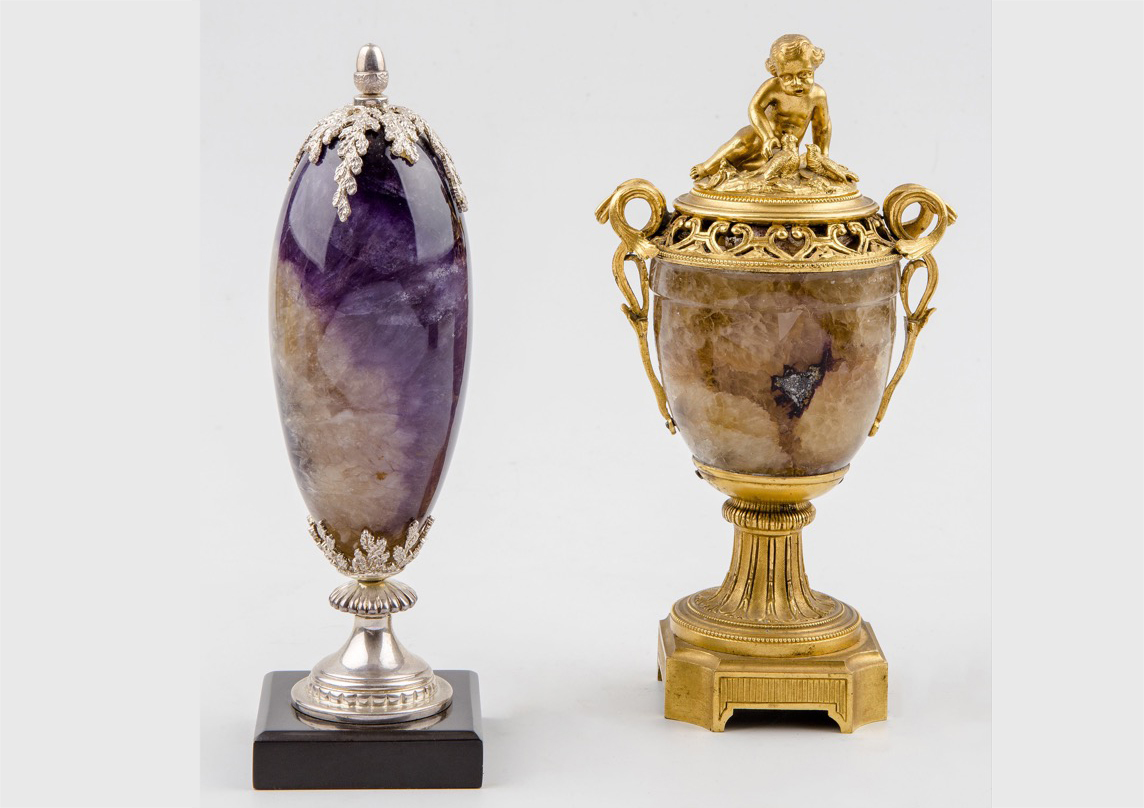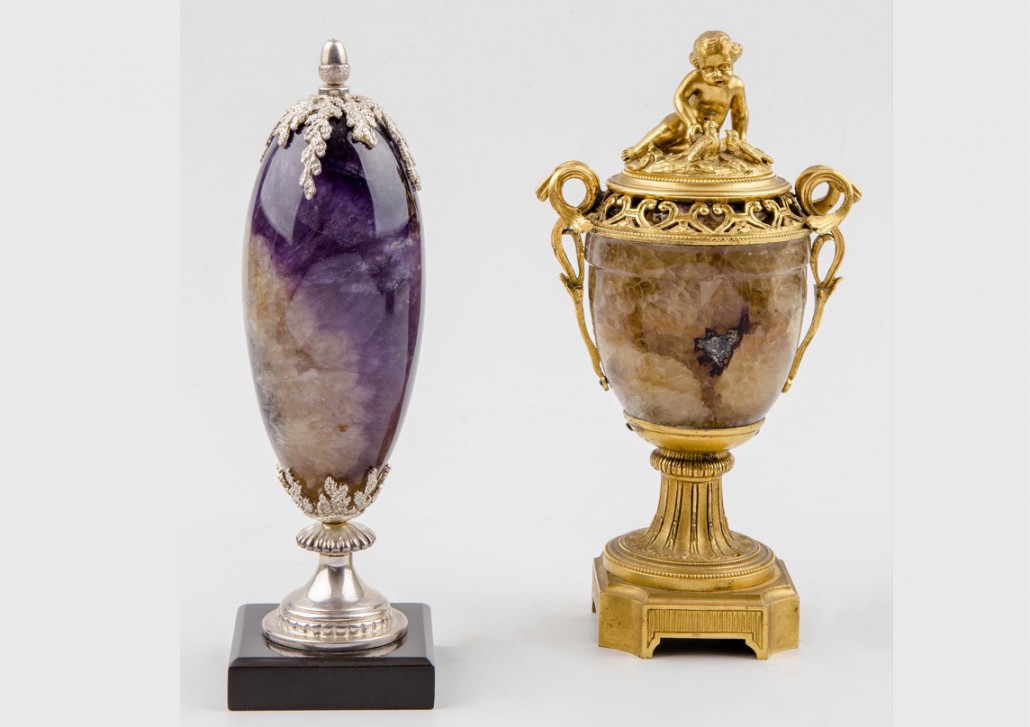
LONDON – The urge to own every antique we find was overcome some years ago. Now our wish list is much shorter and way more refined than it used to be. Somewhere toward the top of mine is an object made from Britain’s scarcest semiprecious stone: Derbyshire’s romantically named Blue John.
I fear the slush fund is in for a hit shortly with the news that Oct. 5 will see the sale of what must be one of the largest privately held collections to come on to the market, certainly in my memory. The clever Birmingham auctioneers, Fellows, will be showing off the 250 lots at Antiques for Everyone summer fair at the National Exhibition Center later this month, so form a queue behind me, please.
I wrote recently about childhood visits to Chatsworth House. It’s where I saw my first piece of Blue John and I’ve been fond of it ever since. The small polished shard of the mineral purchased for me from the shop at the Castleton caves where it was mined is still in my box of treasures. I think I was 7 at the time.
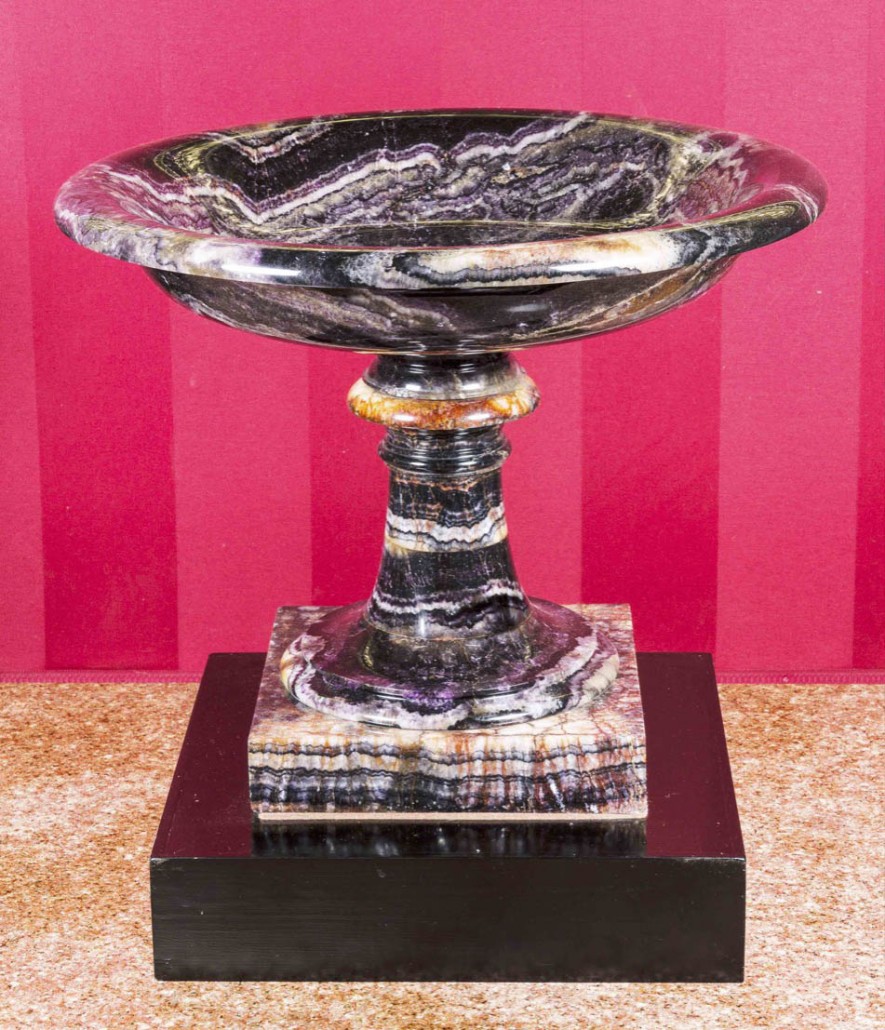
Georgiana Cavendish, Duchess of Devonshire (1757-1806), used to collect Blue John, among other minerals, and in 1842, her husband, William, the 5th Duke and owner of Chatsworth, commissioned the Chatsworth Tazza, one of the largest objects ever made from Blue John.
It was made by William Adam of Matlock and measures 20 inches (51 cms) in diameter and is on display in the dining room at Chatsworth. There are other fine examples in the Royal Collection at Buckingham Palace and Windsor Castle, the Natural History Museum and a visit to Buxton Museum is also worth the trip. Apparently, there’s also a piece in the White House.
The display at Antiques for Everyone – the fair runs July 23-26 – is set to be inspirational. Neo-Classical style ornaments dating from the second half of the 18th century, notably by the renowned Birmingham manufacturer, Matthew Boulton (1722-1809) will stand alongside antique jewelry and smaller objects with saleroom values ranging from £30 to £30,000.
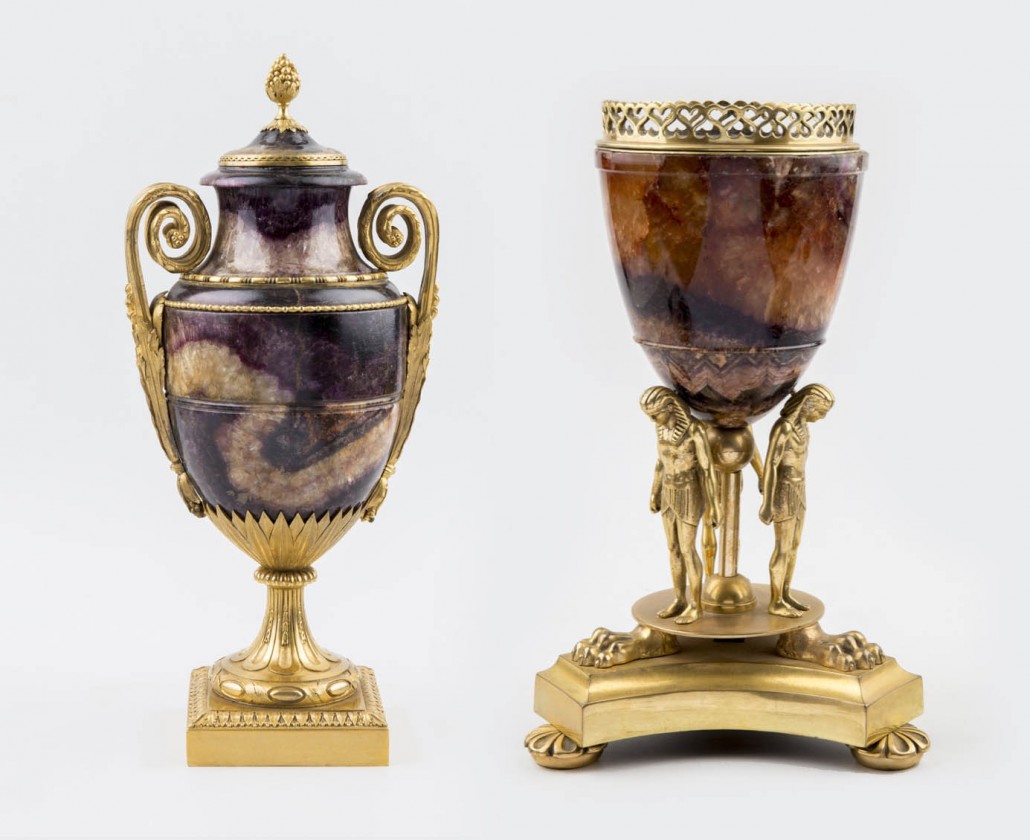
The distinctive mineral is calcium fluoride that has been colored by films of oils deposited on the crystals over millennia. Castleton is the only place in the world where it is found. Mining continues today, but only on a modest scale, the mines at Blue John Cavern on Mam Tor and Treak Cliff Cavern in Buxton Road, Castleton, being more tourist attractions.
It was first discovered by the Romans while mining for lead and became fashionable as decorative ornaments in the mid-18th century, when caverns containing veins of the semiprecious mineral started commercial output in and around the Derbyshire village.
Blue John, or Derbyshire Spar, takes its name from bleu-jaune (blue-yellow) probably from the days when worked pieces were sent to France to be mounted in ormolu (gilt bronze) and fitted with gilded handles and ornament by French craftsmen. In fact, the more usual colors are amethyst and purple, shot through with veins of mottled lilac, cream and white.
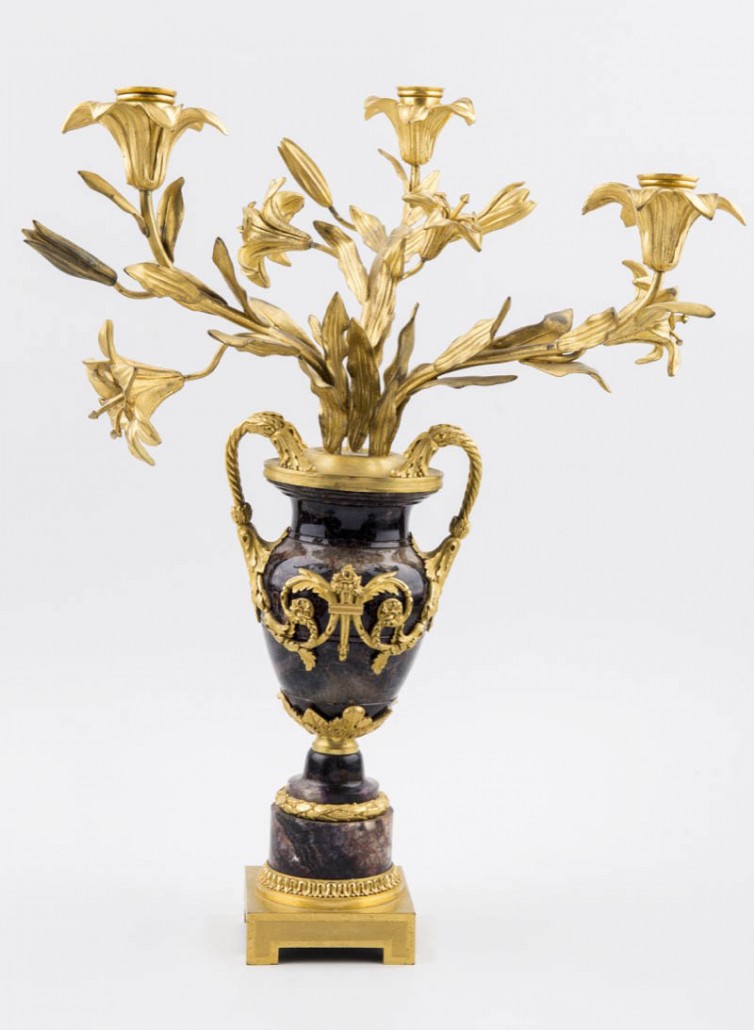
They were copying the work of the pioneer Matthew Boulton at his Soho Works in Birmingham who called the mineral “Blew John.” He produced beautiful objets de vertu in Blue John, mounted in ormolu for rich clients including Catherine the Great, who between 1772 and 1774 purchased vases, clocks and an obelisk.
Alternatively, miners from Cornwall arrived at the Derbyshire mines in the mid-18th century, bringing with them the Cornish name for all fluorspars: “blue jenn,” while another possibility derives from the old miner’s term for zinc: “Black Jack,” leading to the natural adoption of Blue John.
The mineral was first used for decorative purposes at Chatsworth House by Samuel Watson between 1690 and 1715. In about 1760, Robert Hall of Castleton, perfected the art of polishing Blue John using a heat process and pine resin and became the first to produce objects made from the mineral on a commercial scale.
In 1762, rare large panels of Blue John were incorporated into the marble fireplace designed by Robert Adam for Kedleston Hall, near Derby. Later, the Victorians, with their love of the natural sciences, were particularly fond of Blue John and all manner of small objects were produced including goblets, paperweights, clock cases, bowls and obelisks to the point where supplies were virtually worked out.
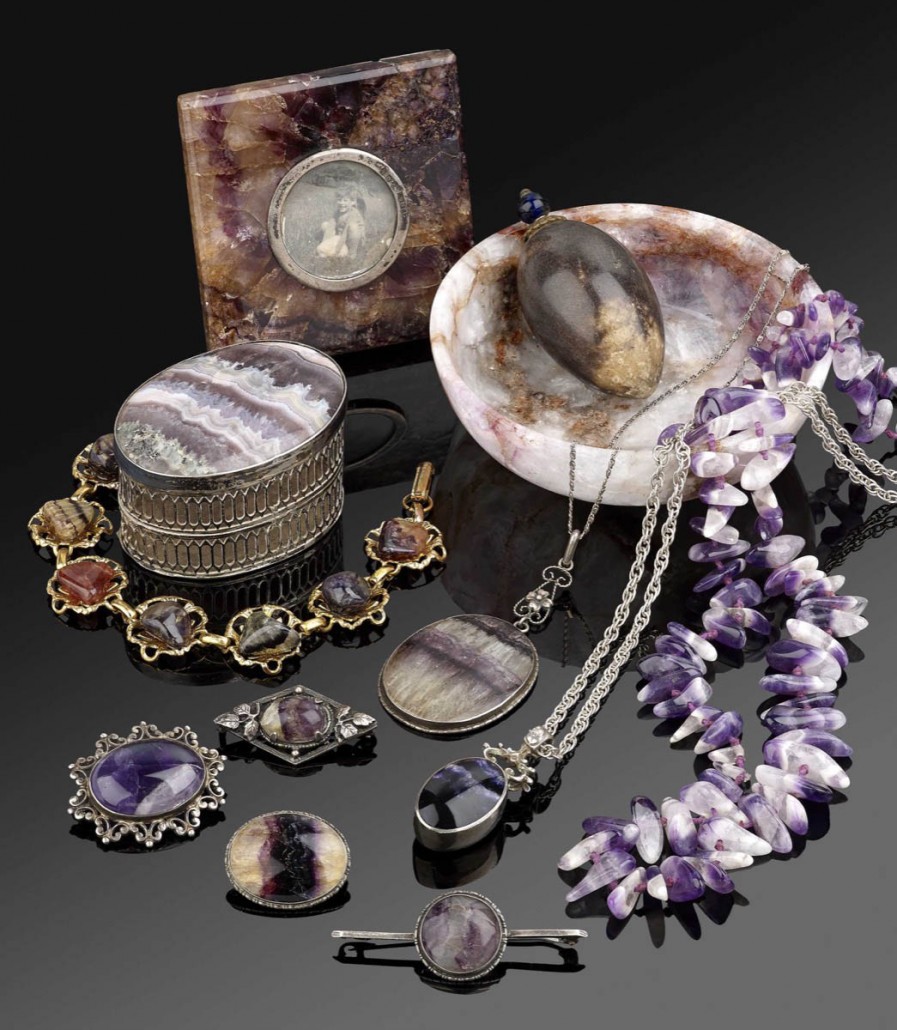
They added jewelry decorated with the mineral to the long list of products to be sought by today’s collectors. New jewelry is still being made and can be purchased from the Blue John Cavern, while larger objects can be commissioned, once a suitable piece of the raw material can be located.
Eighteenth century pieces are now rare and extremely expensive. Nineteenth century examples are somewhat more common, but beware of modern copies made using a similar mineral found in China. The different color is the giveaway.
One man who can give advice to collectors is an exhibitor at Antiques for Everyone, Andrew Elliot from the Antiques Bazaar based in Bakewell, Derbyshire, who once worked in the Blue John mine and was later apprenticed to a master craftsman to learn the special skills required to craft the mineral into ornaments and jewelry to be sold in the mine shop.
Ask the question and he’ll explain how the lumps of raw stone, found either in 3-inch-thick veins or in nodules in the inner walls of cavities in the carboniferous limestone in caverns were extracted entirely by hand using a hammer and chisel.
Extreme care was required because the complexity and structure of the color is so fragile that even a slight disturbance or shock can turn the distinctive bandings to a creamy white, devaluing the piece accordingly. Fashioning of the mineral into ornaments or jewelry was a process fraught with difficulty, as the mineral is fragile in its natural state and prone to breakage.
He told me: “Each new piece started, especially the bowls and tazzas, takes a significant amount of time to finish and perhaps only two or three out of five come to fruition.”
Antiques for Everyone Summer Fair (July 23-26, 2015), organized by Clarion Events Ltd, boasts 200 specialist dealers Admission is £15 (£12 in advance and for senior citizens) including free parking, but organizers Clarion Events has agreed to give Miscellaneana readers two tickets for the price of one. Please mention Auction Central News at the pay booth.
By CHRISTOPHER PROUDLOVE


